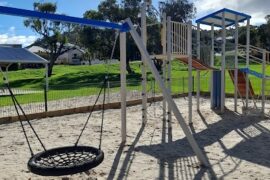Embark on an Interstellar Journey: Neptune’s Mysteries Unveiled for Parents and Kids
Welcome, parents and future astronomers, to a world beyond our own—a world that shimmers with a deep blue hue and twirls majestically through the cosmos. Yes, you guessed it! We’re talking about Neptune, the eighth and farthest known planet from the Sun in our solar system. With this guide, we’ll embark on an interstellar odyssey to unveil the secrets of this distant, icy giant. From its wild winds to its captivating moons, there’s so much for you and your kids to discover about Neptune.
Whether you’re homeschooling, looking for exciting new ways to engage your children in science, or simply in awe of the wonders above, this guide is designed to help you navigate the astronomically awe-inspiring realm of Neptune. Let’s dive in!
Neptune at a Glance: Fast Facts for Quick Learning
- Discovered in 1846: Neptune was the first planet located through mathematical predictions rather than through regular observations of the sky.
- Named after the Roman god of the sea: Its vibrant blue color inspired astronomers to name it after the god of the waters.
- An icy giant: Neptune falls into the category of “ice giants,” with a slushy mix of water, ammonia, and methane ice surrounding its core.
- The windiest planet: Winds on Neptune can reach up to 1,200 miles per hour, the fastest in the solar system.
- A day on Neptune: One day on Neptune lasts about 16 hours, as it rotates faster than Earth despite its larger size.
- The long orbital period: It takes Neptune about 165 Earth years to orbit the Sun once, meaning it has only completed one orbit since its discovery.
Creating a Stellar Learning Experience at Home
Introducing your children to the wonders of the night sky can spark a lifelong love of science and exploration. Here are some ideas for how to weave Neptune into your educational activities:
- Planetary arts and crafts: Channel their inner artist by creating a model of Neptune using papier-mâché, or painting a starry night sky with Neptune as the centerpiece.
- Interactive online simulations: There are many free resources available that simulate space travel and provide interactive experiences with planets, including Neptune.
- Stories and mythology: Dive into the myths of Neptune, the Roman god, to add some historical context to your space exploration.
- Science projects: Simple experiments can demonstrate Neptune’s extreme weather, like creating a “wind vortex” with a fan and a few household items.
- Stargazing nights: Invest in a telescope and pick a night to gaze up at the stars, searching for Neptune, which is often visible with a little assistance from sky maps and apps.
Integrating these activities into your routine not only educates but also strengthens your bond with your children through shared experiences and discoveries. It shows that learning is not just for school—it can be a part of life’s adventure.
Delving Deeper into Neptune’s Blue Depths: The Science of a Distant World
Neptune is a planet with captivating features, and each one holds a scientific explanation waiting to be explored. The deep blue color, for instance, is a result of methane in the atmosphere absorbing red light and reflecting the blue. Discussing such facts can lead to broader discussions on light, color, and how our eyes perceive the world around us. The extreme winds on Neptune are another enticing topic, prompting an investigation into weather patterns, both terrestrial and extraterrestrial.
Parents, as you quench your thirst and your kids’ curiosity about this remote world, remember you’re laying the foundation for critical thinking and a scientific mindset. Every question they ask and every answer you explore together contributes to their understanding of the universe and their place within it. Neptune’s distant glow, visible across the abyss of space and time, becomes a beacon of knowledge, igniting young minds with excitement and wonder.
The journey to Neptune might be vast and unimaginable, but the journey of learning is infinite and entirely within reach. Stay tuned as we delve further into the enchanting world of Neptune, where the facts are as fascinating as the fiction, and every discovery is another page in the storybook of our universe.

Five Things Parents Should Know Before Preparing for Neptune’s Adventure
Before diving into Neptune’s vast blue mysteries, here are five important tips every parent should consider:
- Understanding the Visibility of Neptune: Neptune is not visible to the naked eye due to its great distance from Earth. Make sure to have access to a decent telescope or plan a visit to a local observatory to catch a glimpse of this distant planet. Applications and websites can also guide you to the right time and position to view Neptune.
- Dealing with the Concept of Scale: Neptune’s sheer size and distance can be hard to grasp, especially for young children. Utilize models or online simulations to impart the vastness of space and the relative size of Neptune compared to Earth and other celestial bodies.
- Tapping into Interactive Learning: Kids often learn better through interactive and hands-on activities. Search for engaging educational games or apps that offer visual and tactile experiences about Neptune, its environment, and its role in our solar system.
- Preparing for In-depth Questions: Your child’s curiosity may lead to profound questions about the universe. Be ready to conduct some research together or direct them to credible sources of information, ensuring that their quest for knowledge about Neptune is both accurate and fulfilling.
- Safety First During Stargazing: When engaging in stargazing activities, it is essential to emphasize the importance of never looking directly at the Sun, even through a telescope, unless with the proper solar filters. Also, always supervise children when they use optical instruments to explore the heavens.
Remember, the expedition to Neptune is not just about fact-finding— it’s about instilling a sense of wonder and the joy of discovery. Let the boundless sky be the ultimate canvas for imagination, and team up with your kids to paint it with the bright colors of knowledge and creativity!
Conclusion
Neptune’s icy allure offers a unique and thrilling opportunity for parents to engage children with the cosmos. As we reflect on the planet’s striking blue presence in our solar system, it’s easy to see why it has captivated the hearts and minds of humans for centuries. When it comes to nurturing the next generation of explorers, scientists, and dreamers, there’s no place like the edge of our own solar neighborhood, where Neptune quietly orbits in its own serene beauty. Unraveling the mysteries of this distant giant together can be one of the most rewarding experiences for both you and your children.
So, dear parents and guardians of the stars in your own homes, let this guide serve as a starting point for your educational journey through the cosmos. Neptune awaits, and with it, a universe of possibilities—each discovery another step into the great unknown, where learning and imagination collide. The adventure is just beginning, so seize the telescope, gather your star maps, and embark on an astronomical adventure that extends beyond our world and into the depths of your child’s imagination!
For more great articles please see here. For more information see here
Disclaimer
The articles available via our website provide general information only and we strongly urge readers to exercise caution and conduct their own thorough research and fact-checking. The information presented should not be taken as absolute truth, and, to the maximum extent permitted by law, we will not be held liable for any inaccuracies or errors in the content. It is essential for individuals to independently verify and validate the information before making any decisions or taking any actions based on the articles.




